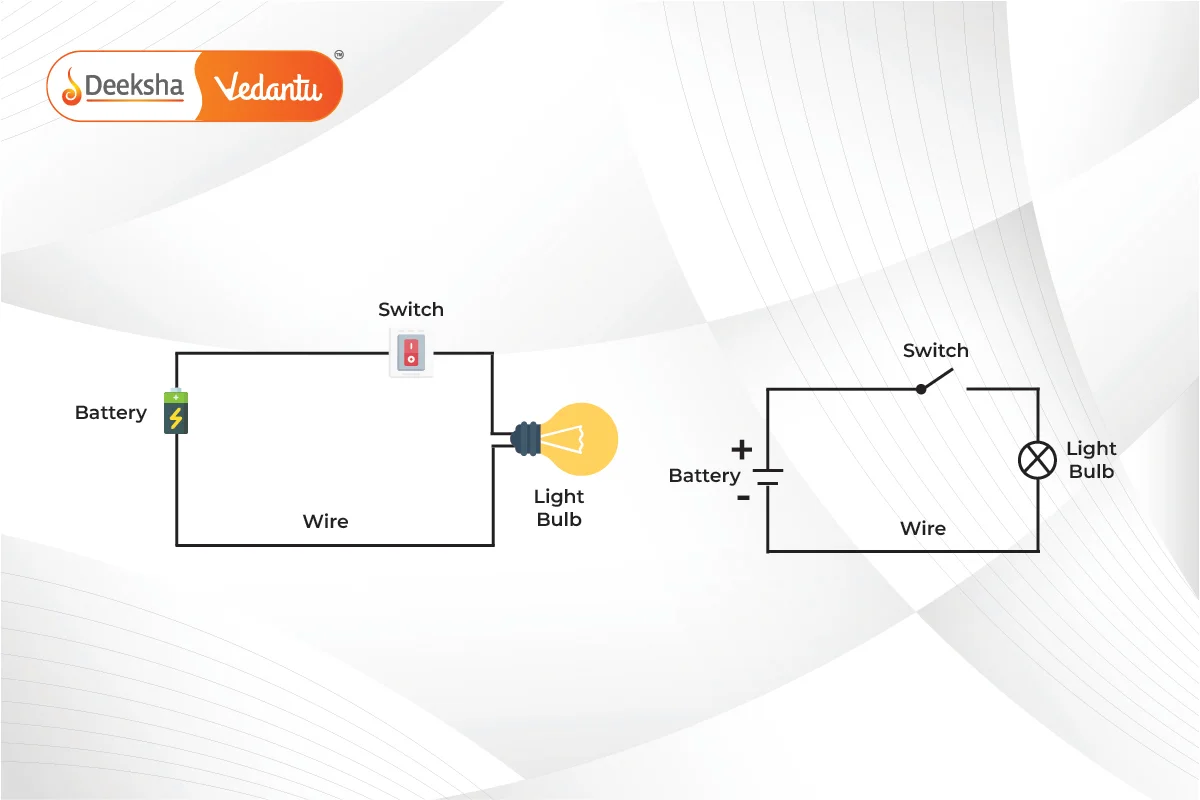Introduction to Electricity
Electricity is a form of energy resulting from the movement of charged particles, typically electrons. It is essential in modern life, powering homes, industries, hospitals, and communication systems. Whether it’s lighting a bulb, operating appliances, or powering electric vehicles, electricity is a versatile form of energy that can be converted into various other forms like heat, light, and mechanical energy.
Understanding electricity helps us grasp how electric circuits work and how to safely and efficiently manage electrical energy. This chapter covers essential topics such as electric current, potential difference, Ohm’s law, resistance, and the heating effect of electric current.
Electric Current and Circuit
What is Electric Current?
Electric current is the flow of electric charge. In most practical applications, this charge is carried by electrons moving through a conductor like a metal wire. The flow of electric current is driven by a difference in electric potential (voltage) between two points.
The rate of flow of electric charge is defined as electric current, and it is measured in amperes (A). The instrument used to measure electric current is called an ammeter.
Where:
= electric current (in amperes)
= charge (in coulombs)
= time (in seconds)
One ampere is defined as the flow of one coulomb of charge passing through a conductor in one second. A coulomb is a large unit of charge equivalent to the charge carried by approximately electrons.
Electric Circuit
An electric circuit is a complete and closed path for electric current to flow. The circuit typically consists of:
- Power Source: A battery or generator that provides potential difference (voltage).
- Conducting Wires: These wires carry the current through the circuit.
- Resistors or Appliances: Devices that use the electrical energy, such as bulbs, motors, or heating elements.
- Switch: A control device that opens or closes the circuit.

In an electric circuit, the direction of current is taken to be from the positive terminal of the battery to the negative terminal, although electrons move in the opposite direction.
Electric Potential and Potential Difference
What is Electric Potential?
Electric potential at a point is the amount of electric potential energy that a unit charge would have at that point. However, what drives electric current is the potential difference (voltage) between two points in a circuit.
Potential Difference (Voltage)
The potential difference between two points is the work done in moving a unit charge from one point to another. The SI unit of potential difference is the volt (V), named after Alessandro Volta.
Where:
= potential difference (in volts)
= work done (in joules)
= charge (in coulombs)
One volt is defined as the potential difference when one joule of work is done to move one coulomb of charge. A voltmeter is used to measure potential difference, and it is always connected in parallel across a component.
Example:
A potential difference of 15 V is applied across a circuit, and 3 C of charge moves through the circuit. Calculate the work done.
Solution:
- V=15 V, Q=3 C
- W=V×Q=15×3=45 J
Ohm’s Law
Definition
Ohm’s Law is one of the fundamental principles of electricity. It states that the current III flowing through a conductor between two points is directly proportional to the potential difference V across the two points, provided the temperature remains constant.
Where:
= potential difference (in volts)
= current (in amperes)
= resistance (in ohms, Ω)
This equation implies that if the potential difference across a conductor increases, the current through it also increases, provided the resistance remains the same.
Resistance
Resistance is the property of a conductor to oppose the flow of electric current. Every material has some amount of resistance. The SI unit of resistance is the ohm (Ω), named after Georg Simon Ohm, who discovered Ohm’s Law.
The resistance of a conductor depends on:
- Length of the conductor: Longer conductors have more resistance.
- Cross-sectional area: Thicker conductors have less resistance.
- Material: Conductors like copper have lower resistance, while materials like nichrome have higher resistance.
- Temperature: For most conductors, resistance increases with temperature.
The relationship between resistance, the length of the conductor l, and the cross-sectional area A is given by:
Where:
= resistivity of the material (a property of the material)
= length of the conductor
= cross-sectional area of the conductor
Resistivity
Resistivity is a material-specific property that measures how strongly a material opposes the flow of electric current. Materials with low resistivity, such as copper and aluminum, are good conductors, while materials with high resistivity, such as rubber and glass, are good insulators.
Example:
A wire has a resistance of 10 ohms. If a 5 A current flows through the wire, calculate the potential difference across the wire.
- Solution:
- I=5 A, R=10 Ω
- Using Ohm’s Law: V=IR =5×10=50 V
Resistances in Series and Parallel
Resistors in Series
When resistors are connected end to end, they are said to be connected in series. In a series circuit, the current flowing through all the resistors is the same, but the voltage is divided across each resistor.
The total resistance in a series circuit is the sum of the individual resistances:
Example:
If three resistors of ,
, and
are connected in series, the total resistance is:
Resistors in Parallel
When resistors are connected across the same two points, they are said to be connected in parallel. In a parallel circuit, the potential difference across each resistor is the same, but the current is divided among the resistors.
The reciprocal of the total resistance in a parallel circuit is the sum of the reciprocals of the individual resistances:
Example:
If resistors of ,
, and
are connected in parallel, the total resistance is:
Thus,
Heating Effect of Electric Current
Joule’s Law of Heating
When current flows through a conductor, energy is lost due to the resistance of the conductor, and this energy loss is converted into heat. The heat energy produced due to the flow of electric current is given by Joule’s Law of Heating:
Where:
= heat produced (in joules)
= current (in amperes)
= resistance (in ohms)
= time (in seconds)
This principle is used in devices such as electric heaters, irons, and toasters.
Applications of Heating Effect
- Electric Bulb: The filament of an electric bulb is made of a material with high resistance (typically tungsten), which gets heated to a high temperature and emits light when current passes through it.
- Electric Fuse: A fuse is a safety device that protects electrical circuits from overloading. It is made of a material that melts when excessive current flows through it, breaking the circuit and preventing damage.
- Electric Iron and Toaster: These appliances convert electrical energy into heat using a high-resistance wire to generate heat for cooking or ironing.
Electric Power
Definition of Electric Power
Electric power is the rate at which electrical energy is consumed or converted into other forms of energy, such as heat, light, or mechanical energy. It is measured in watts (W).
Where: –
= Power (in watts)
= Voltage (in volts)
= Current (in amperes)
= Resistance (in ohms)
Power Ratings
Power ratings of electrical appliances indicate how much power they consume when operating at a specific voltage. For example, a 100 W light bulb consumes 100 joules of electrical energy per second when connected to a 220 V supply.
Example:
Calculate the power consumed by a heater operating at 220 V with a current of 5 A.
- Solution:
Units of Electrical Energy
The unit of electrical energy is the kilowatt-hour (kWh). One kilowatt-hour is the amount of electrical energy consumed when a device of power rating 1 kW operates for one hour.
Real-Life Applications of Electricity
- Home Appliances: Devices like televisions, refrigerators, washing machines, and microwaves depend on electricity for operation. Modern homes are equipped with various electric appliances that make life convenient and efficient.
- Transportation: Electric vehicles (EVs) use electricity to power their motors, offering a cleaner and more sustainable alternative to gasoline-powered vehicles. Electric trains and metros also rely on electricity for smooth and efficient operation.
- Healthcare: Electricity powers life-saving equipment like ventilators, MRI scanners, and X-ray machines. Without electricity, many medical procedures would be impossible.
- Communication: The internet, mobile phones, and satellites use electrical signals to transmit data over vast distances, allowing instant global communication.
- Industry and Manufacturing: Factories use electricity to power machines and automated production lines, significantly increasing productivity and efficiency in manufacturing processes.
Key Practice Questions
- Question: A 6 V battery is connected to a bulb with a resistance of
. Calculate the current flowing through the circuit.
- Answer:
- Answer:
- Question: What is the total resistance of three resistors connected in series with resistances of
,
, and
?
- Answer:
- Answer:
- Question: Calculate the power consumed by an electric iron that draws a current of 4 A and is connected to a 220 V supply.
- Answer:
- Answer:
FAQs
An electric fuse melts because of the heating effect of electric current. Excessive current generates heat that melts the fuse wire, breaking the circuit and preventing damage to appliances.
Electric power is the rate at which electrical energy is consumed or converted into other forms of energy. It is measured in watts (W).
In a series circuit, the components are connected end-to-end, and the current is the same through each component. In a parallel circuit, the components are connected across the same two points, and the voltage across each component is the same, but the current divides among the branches.
The SI unit of electric current is the ampere (A).



![Rendered by QuickLaTeX.com \[\boldsymbol{V = \frac{\textbf{W}}{\textbf{Q}}}\]](https://deekshalearning.com/wp-content/ql-cache/quicklatex.com-d7fee8a5d4994f7ad35e23b657ba1813_l3.png)
![Rendered by QuickLaTeX.com \[\boldsymbol{\frac{1}{R_p} = \frac{1}{R_1} + \frac{1}{R_2} + \frac{1}{R_3}}\]](https://deekshalearning.com/wp-content/ql-cache/quicklatex.com-64602bca505adc1bac72b98cb6005b90_l3.png)

![Rendered by QuickLaTeX.com \[\boldsymbol{P = I^2 R = \frac{V^2}{R}}\]](https://deekshalearning.com/wp-content/ql-cache/quicklatex.com-571a638c8d38909bbc73aa6a7a0e9fa0_l3.png)




Get Social